Characteristics of High-Latitude Climate and Cloud Simulation in Community Atmospheric Model Version 6 (CAM6)
Abstract
:1. Introduction
2. Methods
2.1. Model and Experimental Design
2.2. Observational Data
3. Results
4. Summary and Discussion
Author Contributions
Funding
Institutional Review Board Statement
Informed Consent Statement
Data Availability Statement
Acknowledgments
Conflicts of Interest
References
- Johannessen, O.M.; Kuzmina, S.I.; Bobylev, L.P.; Miles, M.W. Surface air temperature variability and trends in the Arctic: New amplification assessment and regionalisation. Tellus A Dyn. Meteorol. Oceanogr. 2016, 68, 28234. [Google Scholar] [CrossRef] [Green Version]
- Serreze, M.C.; Barry, R.G. Processes and impacts of Arctic ampli fi cation: A research synthesis. Glob. Planet. Chang. 2011, 77, 85–96. [Google Scholar] [CrossRef]
- Deser, C.; Walsh, J.E.; Timlin, M.S. Arctic Sea Ice Variability in the Context of Recent Atmospheric Circulation Trends. J. Clim. 2000, 13, 617–633. [Google Scholar] [CrossRef]
- Lu, J.; Cai, M. Seasonality of polar surface warming amplification in climate simulations. Geophys. Res. Lett. 2009, 36, 1–6. [Google Scholar] [CrossRef]
- Pithan, F.; Mauritsen, T. Arctic amplification dominated by temperature feedbacks in contemporary climate models. Nat. Geosci. 2014, 7, 2–5. [Google Scholar] [CrossRef]
- Cohen, J.; Screen, J.A.; Furtado, J.C.; Barlow, M.; Whittleston, D.; Coumou, D.; Francis, J.; Dethloff, K.; Entekhabi, D.; Overland, J.; et al. Recent Arctic amplification and extreme mid-latitude weather. Nat. Geosci. 2014, 7, 627–637. [Google Scholar] [CrossRef] [Green Version]
- Kug, J.-S.; Jeong, J.-H.; Jang, Y.-S.; Kim, B.-M.; Folland, C.K.; Min, S.-K.; Son, S.-W. Two distinct influences of Arctic warming on cold winters over North America and East Asia. Nat. Geosci. 2015, 8, 759–762. [Google Scholar] [CrossRef]
- Screen, J.A.; Simmonds, I. Exploring links between Arctic amplification and mid-latitude weather. Geophys. Res. Lett. 2013, 40, 959–964. [Google Scholar] [CrossRef] [Green Version]
- Wu, Y.; Smith, K.L. Response of Northern Hemisphere Midlatitude Circulation to Arctic Amplification in a Simple Atmospheric General Circulation Model. J. Clim. 2016, 29, 2041–2058. [Google Scholar] [CrossRef]
- Boe, J.; Hall, A.; Qu, X. Current GCMs’ Unrealistic Negative Feedback in the Arctic. J. Clim. 2009, 22, 4682–4695. [Google Scholar] [CrossRef] [Green Version]
- de Boer, G.; Chapman, W.L.; Kay, J.E.; Medeiros, B.; Shupe, M.D.; Vavrus, S.; Walsh, J.E. A Characterization of the Present-Day Arctic Atmosphere in CCSM4. J. Clim. 2012, 25, 2676–2695. [Google Scholar] [CrossRef]
- Karlsson, J.; Svensson, G. Consequences of poor representation of Arctic sea-ice albedo and cloud-radiation interactions in the CMIP5 model ensemble. Geophys. Res. Lett. 2013, 40, 4374–4379. [Google Scholar] [CrossRef]
- Barton, N.P.; Klein, S.A.; Boyle, J.S. On the Contribution of Longwave Radiation to Global Climate Model Biases in Arctic Lower Tropospheric Stability. J. Clim. 2014, 27, 7250–7269. [Google Scholar] [CrossRef]
- English, J.M.; Gettelman, A.; Henderson, G.R. Arctic radiative fluxes: Present-day biases and future projections in CMIP5 models. J. Clim. 2015, 28, 6019–6038. [Google Scholar] [CrossRef]
- Baek, E.H.; Kim, J.H.; Park, S.; Kim, B.M.; Jeong, J.H. Impact of poleward heat and moisture transports on Arctic clouds and climate simulation. Atmos. Chem. Phys. 2020, 20, 2953–2966. [Google Scholar] [CrossRef] [Green Version]
- Cesana, G.; Chepfer, H. How well do climate models simulate cloud vertical structure? A comparison between CALIPSO-GOCCP satellite observations and CMIP5 models. Geophys. Res. Lett. 2012, 39, 1–6. [Google Scholar] [CrossRef] [Green Version]
- Kay, J.E.; Bourdages, L.; Miller, N.B.; Morrison, A.; Yettella, V.; Chepfer, H.; Eaton, B. Evaluating and improving cloud phase in the Community Atmosphere Model version 5 using spaceborne lidar observations. J. Geophys. Res. Atmos. 2016, 121, 4162–4176. [Google Scholar] [CrossRef] [Green Version]
- Cesana, G.; Waliser, D.E.; Jiang, X.; Li, J.-L.F. Multi-model evaluation of cloud phase transition using satellite and reanalysis data. J. Geophys. Res. Atmos. 2015, 120, 7871–7892. [Google Scholar] [CrossRef]
- English, J.M.; Kay, J.E.; Gettelman, A.; Liu, X.; Wang, Y.; Zhang, Y.; Chepfer, H. Contributions of clouds, surface albedos, and mixed-phase ice nucleation schemes to Arctic radiation biases in CAM5. J. Clim. 2014, 27, 5174–5197. [Google Scholar] [CrossRef] [Green Version]
- Park, S.; Bretherton, C.S.; Rasch, P.J. Integrating Cloud Processes in the Community Atmosphere Model, Version 5. J. Clim. 2014, 27, 6821–6856. [Google Scholar] [CrossRef]
- Tan, I.; Storelvmo, T. Sensitivity study on the influence of cloud microphysical parameters on mixed-phase cloud thermodynamic phase partitioning in CAM5. J. Atmos. Sci. 2016, 73, 709–728. [Google Scholar] [CrossRef]
- Zhang, M.; Liu, X.; Diao, M.; D’Alessandro, J.J.; Wang, Y.; Wu, C.; Zhang, D.; Wang, Z.; Xie, S. Impacts of Representing Heterogeneous Distribution of Cloud Liquid and Ice on Phase Partitioning of Arctic Mixed-Phase Clouds with NCAR CAM5. J. Geophys. Res. Atmos. 2019, 124, 13071–13090. [Google Scholar] [CrossRef]
- Danabasoglu, G.; Lamarque, J.F.; Bacmeister, J.; Bailey, D.A.; DuVivier, A.K.; Edwards, J.; Emmons, L.K.; Fasullo, J.; Garcia, R.; Gettelman, A.; et al. The Community Earth System Model Version 2 (CESM2). J. Adv. Model. Earth Syst. 2020, 12, e2019MS001916. [Google Scholar] [CrossRef] [Green Version]
- McIlhattan, E.A.; Kay, J.E.; L’Ecuyer, T.S. Arctic Clouds and Precipitation in the Community Earth System Model Version 2. J. Geophys. Res. Atmos. 2020, 125, e2020JD032521. [Google Scholar] [CrossRef] [PubMed]
- Larson, V.E. CLUBB-SILHS: A parameterization of subgrid variability in the atmosphere. arXiv 2017, arXiv:1711.03675v2. [Google Scholar]
- Bogenschutz, P.A.; Gettelman, A.; Morrison, H.; Larson, V.E.; Craig, C.; Schanen, D.P. Higher-order turbulence closure and its impact on climate simulations in the community atmosphere model. J. Clim. 2013, 26, 9655–9676. [Google Scholar] [CrossRef]
- Morrison, H.; Gettelman, A. A New Two-Moment Bulk Stratiform Cloud Microphysics Scheme in the Community Atmosphere Model, Version 3 (CAM3). Part I: Description and Numerical Tests. J. Clim. 2008, 21, 3642–3659. [Google Scholar] [CrossRef]
- Gettelman, A.; Morrison, H.; Santos, S.; Bogenschutz, P.; Caldwell, P.M. Advanced Two-Moment Bulk Microphysics for Global Models. Part II: Global model solutions and Aerosol-Cloud Interactions. J. Clim. 2015, 28, 1288–1307. [Google Scholar] [CrossRef]
- Liu, X.; Ma, P.L.; Wang, H.; Tilmes, S.; Singh, B.; Easter, R.C.; Ghan, S.J.; Rasch, P.J. Description and evaluation of a new four-mode version of the Modal Aerosol Module (MAM4) within version 5.3 of the Community Atmosphere Model. Geosci. Model Dev. 2016, 9, 505–522. [Google Scholar] [CrossRef] [Green Version]
- Beljaars, A.C.M.; Brown, A.R.; Wood, N. A new parametrization of turbulent orographic form drag. Q. J. R. Meteorol. Soc. 2004, 130, 1327–1347. [Google Scholar] [CrossRef] [Green Version]
- Hurrell, J.W.; Hack, J.J.; Shea, D.; Caron, J.M.; Rosinski, J. A new sea surface temperature and sea ice boundary dataset for the community atmosphere model. J. Clim. 2008, 21, 5145–5153. [Google Scholar] [CrossRef]
- Shaw, J.; McGraw, Z.; Bruno, O.; Storelvmo, T.; Hofer, S. Using Satellite Observations to Evaluate Model Microphysical Representation of Arctic Mixed-Phase Clouds. Geophys. Res. Lett. 2022, 49, e2021GL096191. [Google Scholar] [CrossRef]
- Chepfer, H.; Bony, S.; Winker, D.; Cesana, G.; Dufresne, J.L.; Minnis, P.; Stubenrauch, C.J.; Zeng, S. The GCM-oriented CALIPSO cloud product (CALIPSO-GOCCP). J. Geophys. Res. Atmos. 2010, 115. [Google Scholar] [CrossRef]
- Kay, J.E.; Hillman, B.R.; Klein, S.A.; Zhang, Y.; Medeiros, B.; Pincus, R.; Gettelman, A.; Eaton, B.; Boyle, J.; Marchand, R.; et al. Exposing global cloud biases in the Community Atmosphere Model (CAM) using satellite observations and their corresponding instrument simulators. J. Clim. 2012, 25, 5190–5207. [Google Scholar] [CrossRef]
- Shaocheng, X.; McCoy, R.B.; Klein, S.A.; Cederwall, R.T.; Wiscombe, W.J.; Clothiaux, E.E.; Gaustad, K.L.; Golaz, J.C.; Hall, S.D.; Jensen, M.P.; et al. ARM climate modeling best estimate data: A new data product for climate studies. Bull. Am. Meteorol. Soc. 2010, 91, 13–20. [Google Scholar] [CrossRef] [Green Version]
- Dee, D.P.; Uppala, S.M.; Simmons, A.J.; Berrisford, P.; Poli, P.; Kobayashi, S.; Andrae, U.; Balmaseda, M.A.; Balsamo, G.; Bauer, P.; et al. The ERA-Interim reanalysis: Configuration and performance of the data assimilation system. Q. J. R. Meteorol. Soc. 2011, 137, 553–597. [Google Scholar] [CrossRef]
- Willis, M.D.; Leaitch, W.R.; Abbatt, J.P.D. Processes Controlling the Composition and Abundance of Arctic Aerosol. Rev. Geophys. 2018, 56, 621–671. [Google Scholar] [CrossRef]
- Forbes, R.M.; Ahlgrimm, M. On the representation of high-latitude boundary layer mixed-phase cloud in the ECMWF global model. Mon. Weather Rev. 2014, 142, 3425–3445. [Google Scholar] [CrossRef]
- Lenaerts, J.T.M.; Gettelman, A.; Van Tricht, K.; van Kampenhout, L.; Miller, N.B. Impact of Cloud Physics on the Greenland Ice.heet Near-Surface Climate: A Study with the Community Atmosphere Model. J. Geophys. Res. Atmos. 2020, 125, e2019JD031470. [Google Scholar] [CrossRef]
- Hoose, C.; Kristjánsson, J.E.; Chen, J.P.; Hazra, A. A classical-theory-based parameterization of heterogeneous ice nucleation by mineral dust, soot, and biological particles in a global climate model. J. Atmos. Sci. 2010, 67, 2483–2503. [Google Scholar] [CrossRef]
- Huang, Y.; Dong, X.; Kay, J.E.; Xi, B.; McIlhattan, E.A. The climate response to increased cloud liquid water over the Arctic in CESM1: A sensitivity study of Wegener–Bergeron–Findeisen process. Clim. Dyn. 2021, 56, 3373–3394. [Google Scholar] [CrossRef]

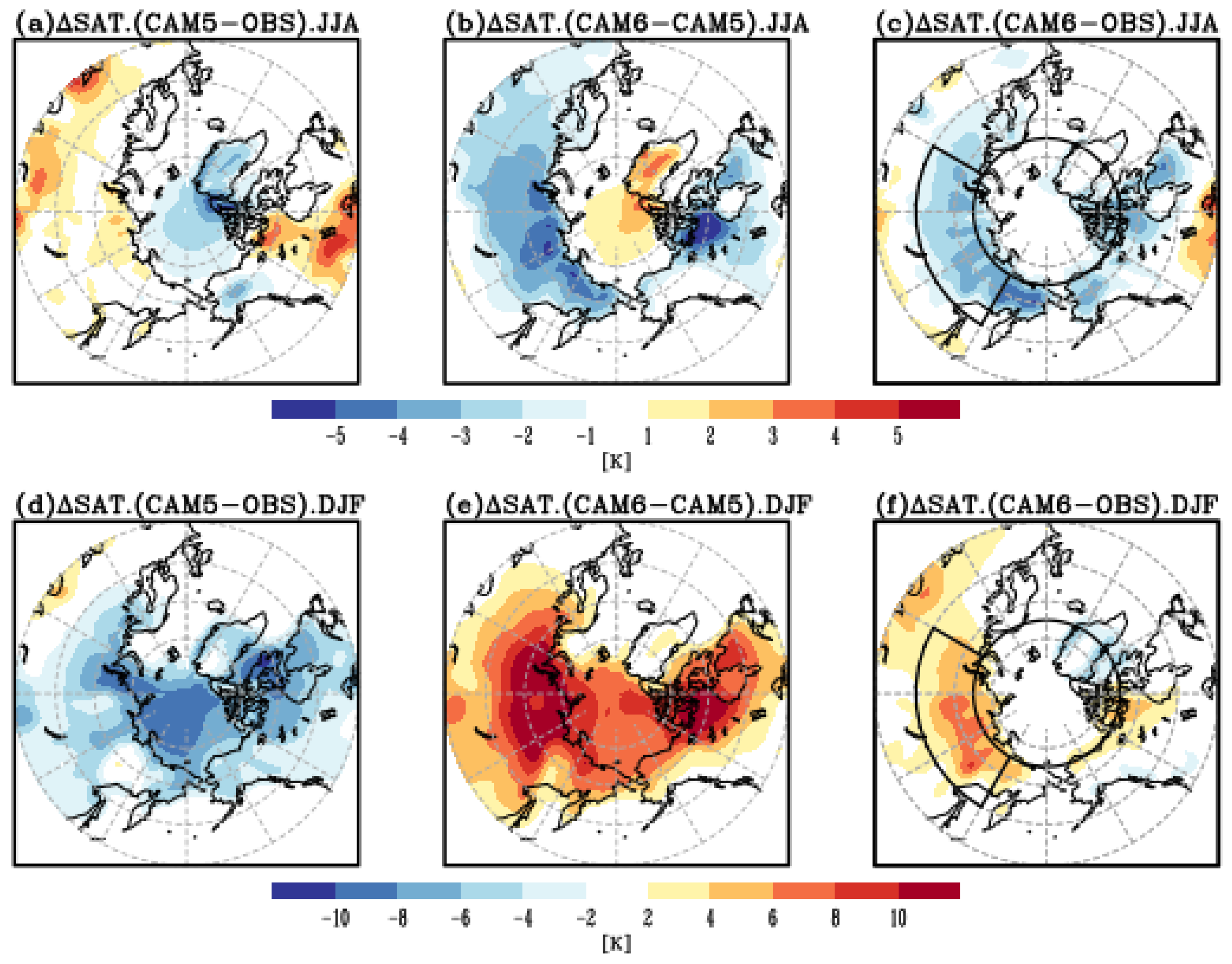

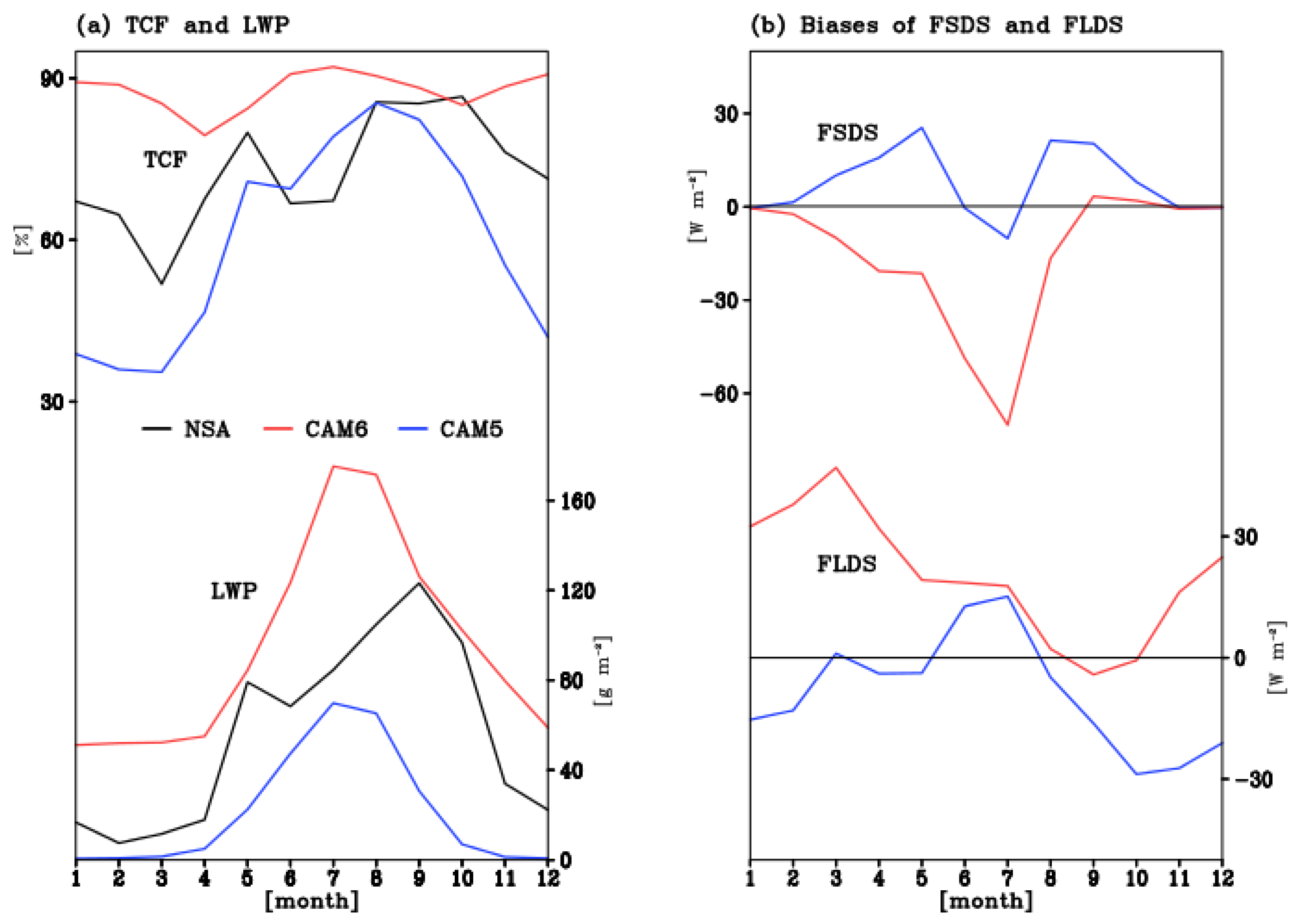
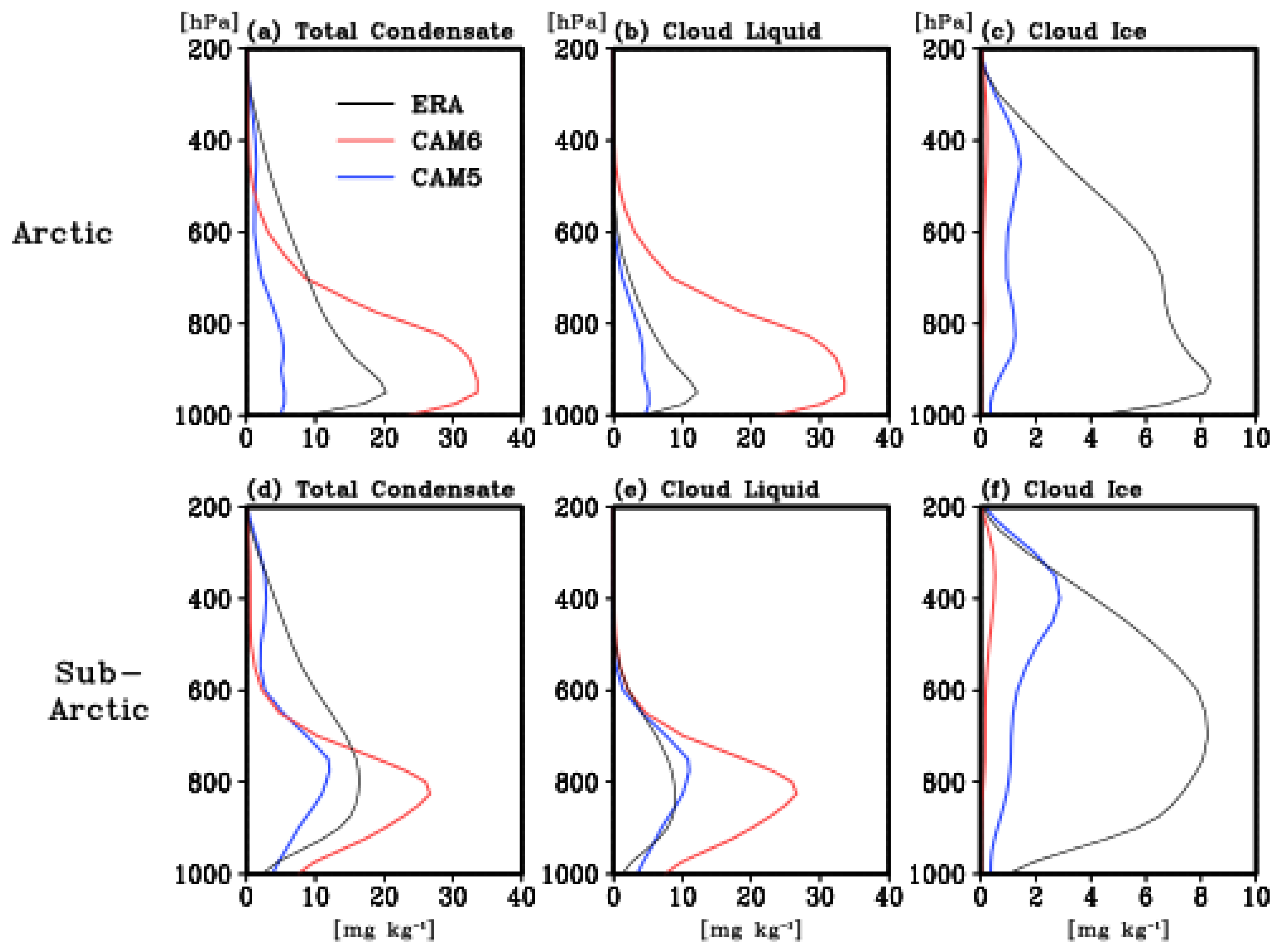
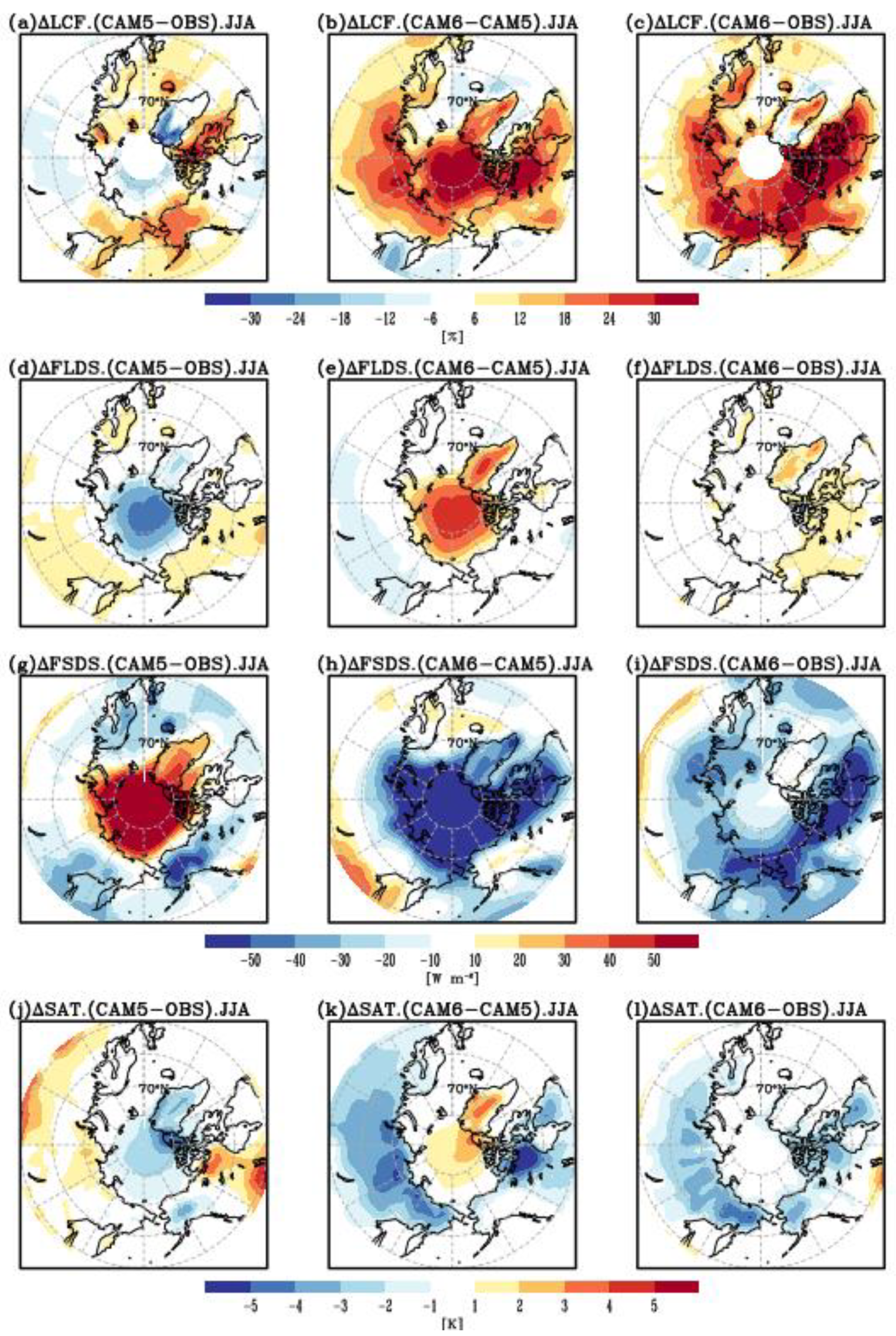

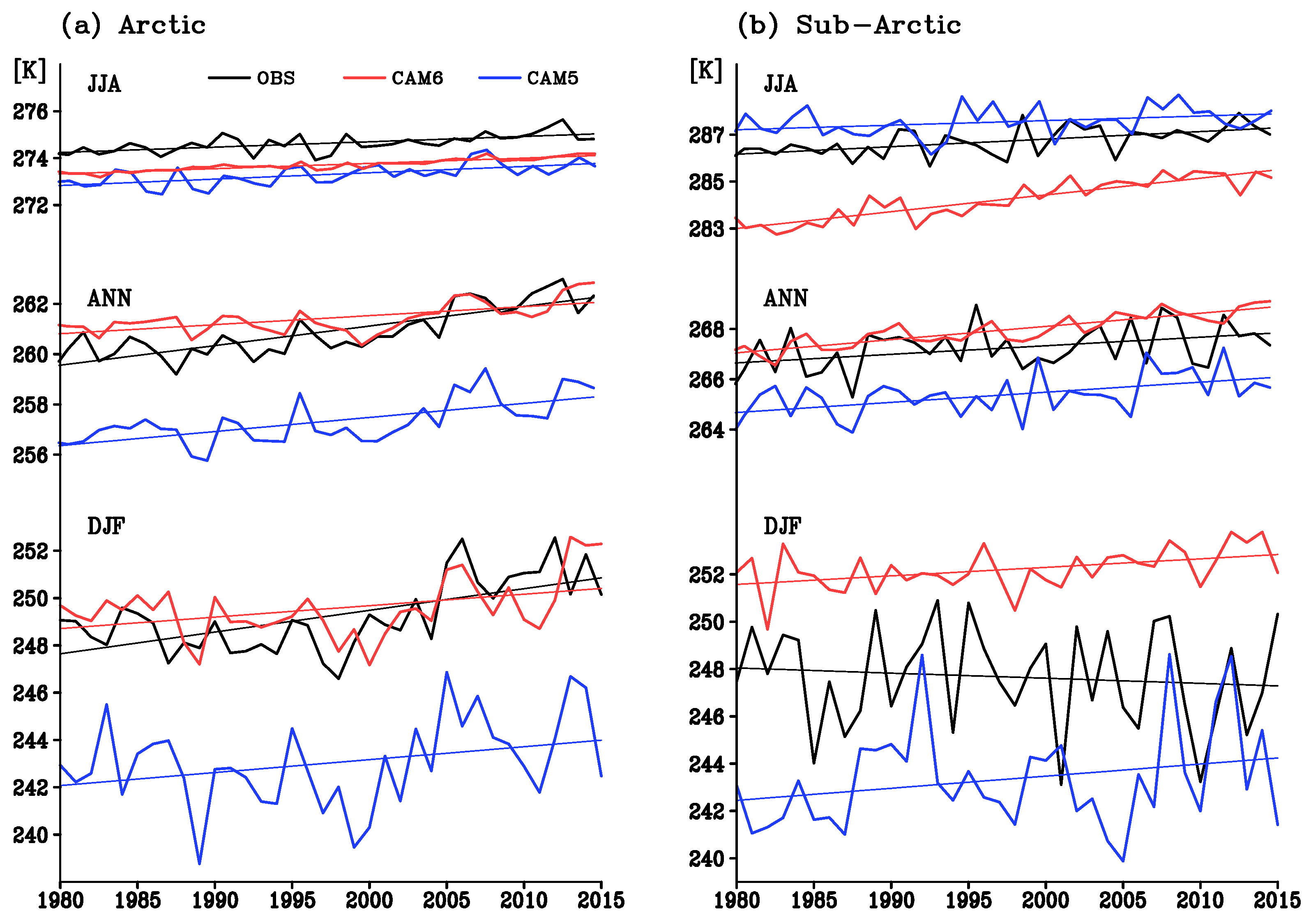

Publisher’s Note: MDPI stays neutral with regard to jurisdictional claims in published maps and institutional affiliations. |
© 2022 by the authors. Licensee MDPI, Basel, Switzerland. This article is an open access article distributed under the terms and conditions of the Creative Commons Attribution (CC BY) license (https://creativecommons.org/licenses/by/4.0/).
Share and Cite
Baek, E.-H.; Bae, J.; Sung, H.-J.; Jung, E.; Kim, B.-M.; Jeong, J.-H. Characteristics of High-Latitude Climate and Cloud Simulation in Community Atmospheric Model Version 6 (CAM6). Atmosphere 2022, 13, 936. https://doi.org/10.3390/atmos13060936
Baek E-H, Bae J, Sung H-J, Jung E, Kim B-M, Jeong J-H. Characteristics of High-Latitude Climate and Cloud Simulation in Community Atmospheric Model Version 6 (CAM6). Atmosphere. 2022; 13(6):936. https://doi.org/10.3390/atmos13060936
Chicago/Turabian StyleBaek, Eun-Hyuk, Jungeun Bae, Hyun-Joon Sung, Euihyun Jung, Baek-Min Kim, and Jee-Hoon Jeong. 2022. "Characteristics of High-Latitude Climate and Cloud Simulation in Community Atmospheric Model Version 6 (CAM6)" Atmosphere 13, no. 6: 936. https://doi.org/10.3390/atmos13060936





